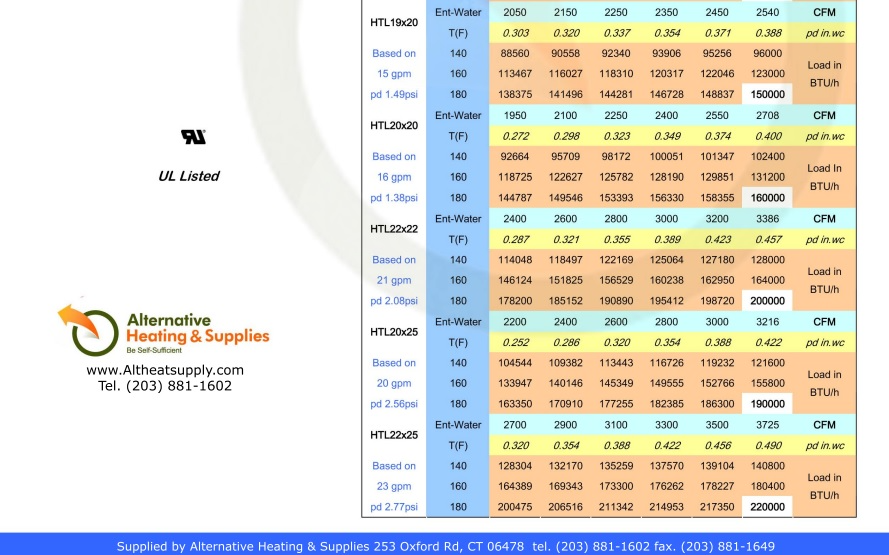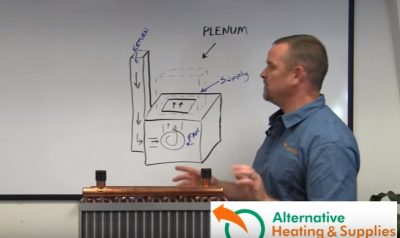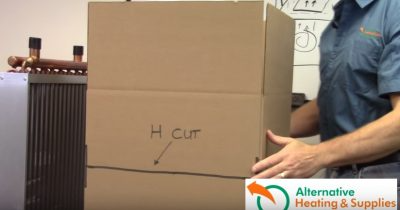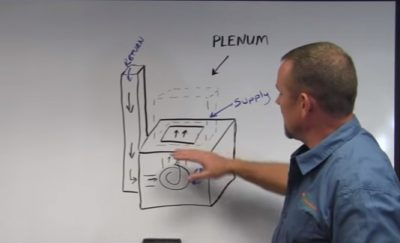Installing Water-To-Air and Water-to-Water Heat Exchangers
Posted by SEBASTIAN ZOTA
This is another Alternative Heating & Supplies episode and in this blog post, we are going to talk about the importance of using heat exchangers and how to install them. Some people call them a hydro coil, some people call them a simple radiator. But what I'm gonna talk to you about is how to install a water to air heat exchanger and the importance of using a water to water heat exchanger in a hot air furnace.
Why Are Heat Exchangers Important
Water to Air Heat Exchangers are designed to fit right into your plenum of your existing hot air furnace to provide the heat your space needs.
Our products are made with the finest quality in the business. Here are the detailed technical specifications of heat exchangers:


Water to Air Heat Exchangers Technical Specifications
Water to Air Heat Exchangers
Where to Install the Water to Air Heat Exchanger?
Okay, one of the important things to recognize is where do I want to install my water to air heat exchanger? Now, when you have a hot air furnace, there are several different variables that matter. A lot of people have oil or propane or natural gas or even wood hot air furnaces. You are going to take all of these things into consideration of where to install the heat exchanger to distribute the heat throughout the house the best.
Technical Considerations to Install a Radiator or a Hydro-Coil
The A-Coil
The first thing that you might want to consider is where is an A-coil that is not in the plenum.

The Heat Exchanger A-Coil
So on the drawing behind me most or all hot air furnaces have a return and then a supply, which comes out the plenum. Now the plenum here is identified by this because I gonna use a cardboard box here in a minute. But what happens is the air gets returned from the house, it gets pushed through a fan, and it gets shot back through, reheated, and sent back through the house. And what I'm gonna do here is I'm gonna use this dotted area and I'm gonna use a cardboard box because that's gonna make it easier for us to work with to give you an idea of what we're doing.

How to Install a Heat Exchanger - The H Cut
Now, this Plenum --simulated in the picture above-- is gonna give us some areas that we need to concern ourselves with. Now, the first question you ask yourself is do you have the AC in the house?"

AC Simulation
And if so, what you'll have is what they call an A-coil, which is usually mounted in the plenum. It is also a radiator or a heat exchanger of some kind of where the freon goes through. And what that does is it gets really cold and it blows air through it and it distributes the AC in your house.
So if you do have an A-coil, I recommend the best way to do it is as high as you can in the plenum. I like a foot or two or anywhere from a foot to two above the A-coil. I have heard them getting too close and they do freeze, believe it or not. So we don't want to deal with that. You will burst them and you will ruin them. So if you get a foot away you're in good shape.
Now the other thing is, is if you don't have an A-coil, you can put your heat exchanger anywhere in the plenum you would like. I personally like it right on top of the hot air furnace.
The Plenum

The Plenum of a Heat Exchanger
As you're seeing here, the fan, the plenum being this dotted line, literally mount it right on the supply side of there's a hole underneath the plenum. All the plenum it is tin. It's a ductwork. It's just tin in a square to direct the air where you want it to go. So if you actually cut into a plenum and look into the plenum on your furnace, you're gonna see the hole where the air comes out. And it's usually considerably smaller than the plenum itself.
And the reason they do that is that they're trying to maximize the size of the plenum to get the most CFM, which is air movement, through the house. So if you have a tighter plenum or a smaller plenum, you're gonna get less air travel. So they try to put the bigger platinum in to get better air travel through the house and less resistance to distribute the air evenly throughout the house.
The Type of Furnace
Another consideration that you might want to think about is depending on the furnace--if it's oil or gas, natural gas, propane, any of the other forms--what they will have here inside this point of the hot air furnace, not in the plenum, is they will actually have an overheating system. So as this jet or this thing is generating heat inside the hot air furnace, the thermostat will keep the fan running until the air is cooled off to cool off the heating element inside the hot air furnace.
How Does a Furnace Work
So what will happen is the oil fire jets--hypothetically oil in this case--the Jets will shoot off and build a flame and heat up a chamber, which is the air is gonna circulate around to distribute hot air. But once the house has been satisfied with the heating temperature that the thermostat is asking for, the jet will turn off and the air will continue to flow to cool that heating element inside the hot air furnace.
A consideration to take is as that air is cooling that heating element is to get the heat exchanger far enough away from that sensor that is basically telling the hot air furnace fan to continue to run until everything is cooled off. If that heat exchanger is a little bit too close, that sensor will not be triggered to say it's cooled off, you can turn off the fan. That'll allow the fan to run continuously and you'll get overheated.
Furnace Installation Tips
So try to put your heat exchanger above any kind of sensors or anything else. They're usually mounted on the side and they're identified by like a Honeywell or some kind of a silver box on the side. Try to get it away from that a little bit so it doesn't trip that sensor.
Furnace Installation FAQs
Another thing that people always ask me about is, "Hey, instead of mounting it on the supply, can I mount it on the return?" Yes, you can, technically.
I do not like it because usually, the returns are much smaller. They're usually long and thin and they're difficult to work with. But you can put them in there. The only reason I do not like them is, again, that sensor which is on the hot air furnace, if the air is coming back it's gonna reheat it back up before it goes into the hot air furnace before it's sent back out to the house. That thermostat, that overheating thermostat, is gonna say that it's never getting cooled off to a point, so the fan will never turn off. That is the reason I don't like doing that.
Another reason is that the heat exchanger will actually reheat the air and these fans will start overheating at about 140-150 miles an hour on the bearings. And it's, if the air is coming in there hot, you might overheat the fan where it'll be turning on and off your fan continuously and be a big nuisance.
And then one more thing that a lot of people will ask me about is does this generate resistance on the fan or does that slow down the air flow through my house? You quite answered that question is simply yes, it sure does. So you want to find a heat exchanger that is gonna maximize the size of your plenum so you get the least amount of resistance.
Now in 95% of the time, you do not have a resistance problem once you install them, but if you do, most of the fans are two and three speed. And the guy or the gal who set that up in your house originally probably doesn't have it on its highest setting. So simply looking at your hot air furnace and pulling off the lid, you'll actually find the dip switches or changing wires will increase the speed of the fan.
I would recommend you talk to an electrician or heating cooling guy to help you with that. But usually, 9 out of 10 times, you can increase the speed to compensate for the resistance that you're gonna generate on the heat exchanger, but most of the time, it's never even a concern. So that's not even something really to worry yourself about.
What I recommend is install it, see if you're not getting enough air through the house, then worry about that aspect of it.
Water to Water Plate Exchangers
What is a Plate Exchanger
A plate exchanger is a water to water heat exchanger used in outdoor wood furnaces.
Why Are Plate Exchangers and Outdoor Wood Furnaces Important
What if there were a way to heat your home, give you all the hot water you need for baths, showers, laundry and more, heat your pool, spa, and anything else you wanted to keep warm with a truly efficient and renewable resource? What if you could help the environment while you were heating your home? What if you could do all this for FREE?
It sounds too good to be true, doesn’t it? But there is a resource that fits all of these specifications. It’s right in your backyard or down the road. Wood.
Now you’re saying, “But that’s old-fashioned and inefficient. Hey, and it’s a lot of work. And it’s dirty too!”
Not true. Wood heating has come of age. The modern exterior wood furnace takes advantage of the latest developments in heating technology. Set up outside your home, and using water and heat exchangers, our furnace burns cleanly and efficiently. In most cases, it can be connected to your existing system to distribute the heat.
Because all your fuel is kept outside, you won’t have the mess associated with indoor stoves. The unit will burn all sizes and types of wood, too…even those unsplittable knotty pieces. And the best part is you only have to feed it once or twice a day – even in the coldest weather. Load it up in the morning and evening, and the unit will do the rest. Water heated to 185 to 200 degrees surrounds the firebox, then it courses through tubing to your home where heat exchangers convert it to hot air which is dispersed by your existing system.
Coal, gas, and oil are fossil-based, non-renewable resources. And in the last year, costs for these commodities have soared. Electricity prices are also climbing.
The environmental impact of these fuels is also a factor that must be considered. The methods used to extract fossil fuels are damaging. Home systems, unless they are constantly and professionally maintained, are not efficient burners. Electricity is often produced by coal-fueled plants or by hydroelectric dams that affect our fragile ecosystems.
There is no other source of warming your home that gives you all the advantages of a timber-fueled system. It’s environmentally friendly, cost-effective, and efficient. And with a little extra work, you can get all this for free. This is an energy source that grows virtually everywhere. The property is constantly being cleared and the leavings are perfect for your use. Haul it home and you and your family are warm all winter for the cost of a tank of gas.
Our company prides itself on bringing you the latest innovations in this technology, along with full-service parts and accessories. We have years of experience and can advise you on choosing the right equipment for your home.
Let us know what you think in the comments on youtube and check-out our next video on How To Mount a Water To Air Heat Exchanger to a Plenum .
Check out our complete list of services and if you need assistance, give us a call!
